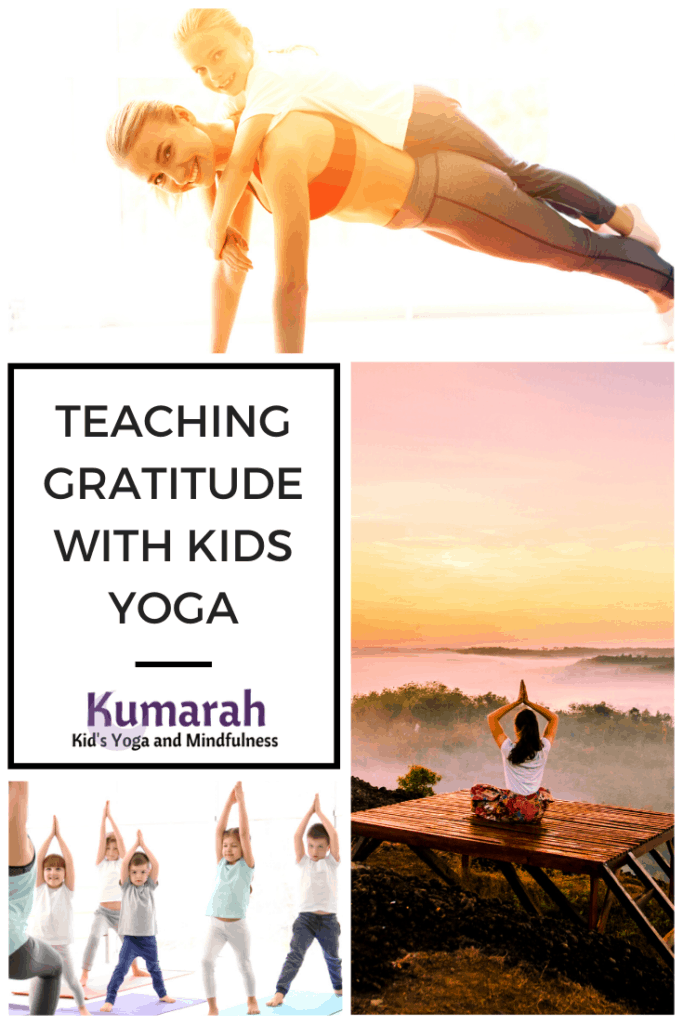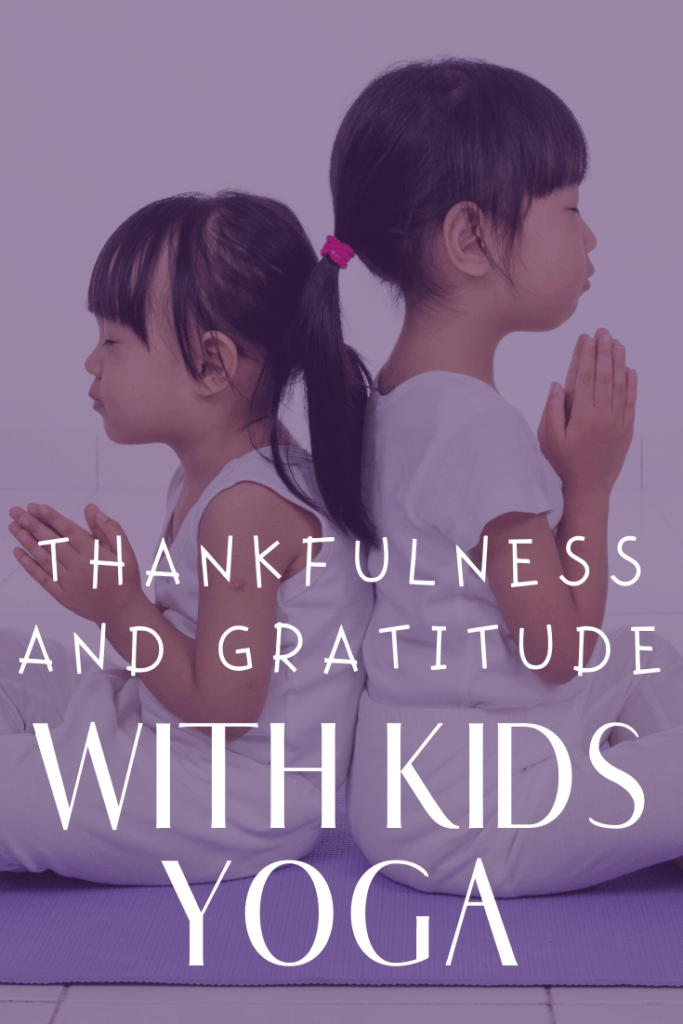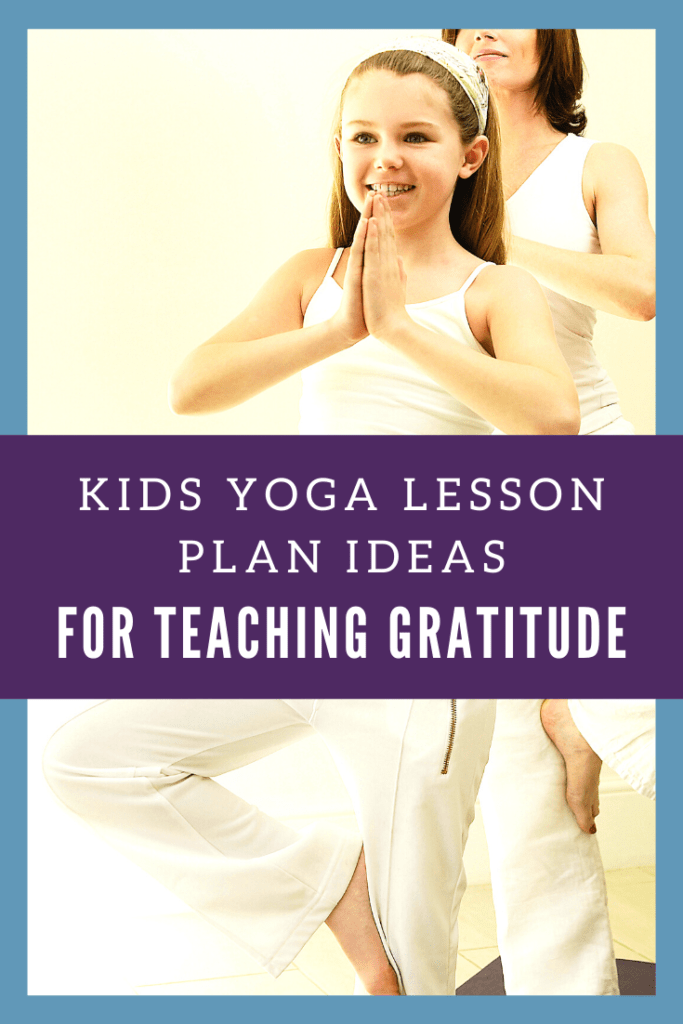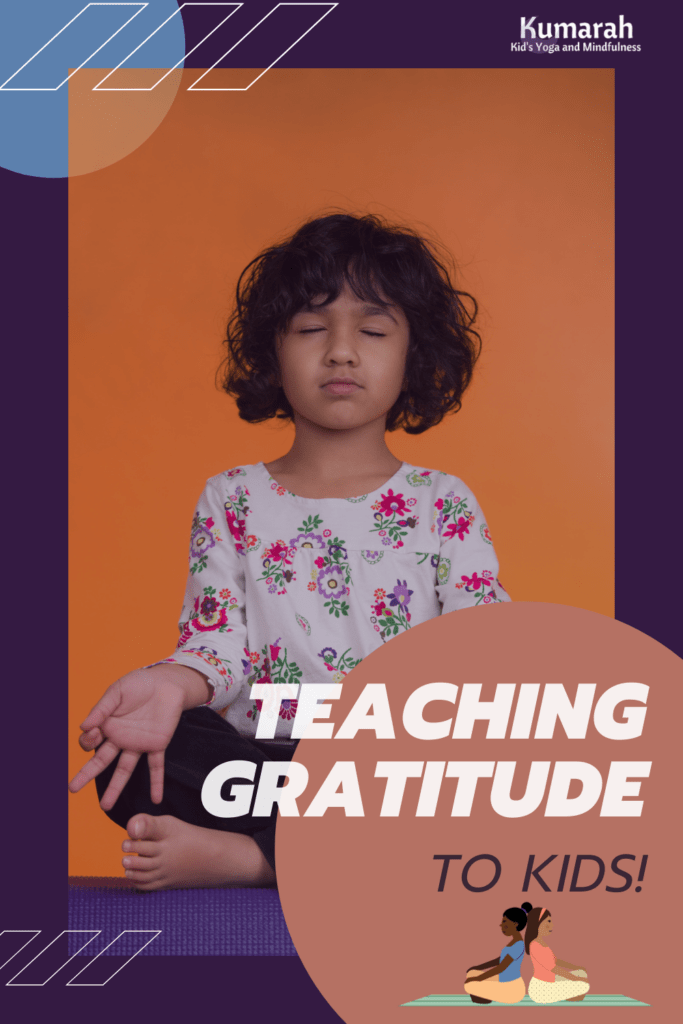*Scroll down for your FREE Gratitude Workbook for kids– 13 pages PDF!
Is gratitude a part of yoga? Absolutely.
Can you teach kids gratitude with the help of yoga or mindfulness?
Absolutely!
Many folks who teach kids yoga in the United States use a very secular version of yoga, focusing mostly on the physical poses and the benefits of the practice as an exercise.
However, traditional yoga intrinsically has a set of morals that can inspire us to live a life of gratitude, self-love, and caring for others (among other things).
Teaching kids yoga in an elementary school, I think a lot about how to use the principals of yoga to weave into my daily lessons without getting too much into yoga philosophy.
Kids can learn gratitude when they are learning yoga, no matter where you are.
I personally need to be careful to keep my teachings secular in my public school, so I stay away from the phrases “Yamas and Niyamas” and the Eight Limbs of Yoga.
(There are ways to incorporate these ideas and morals though, even in a public school!)
But I still think that it is my job as a teacher of yoga to help kids learn about some of the more important morals in these philosophies:
Like being kind to others and practicing gratitude.
Kids need to be shown by example and taught directly how to practice gratitude. Many adults could do with relearning the practice as well. 🙂
Learning how to be grateful is such an important part of learning empathy and self-love–kids should start learning how to practice gratitude from an early age!
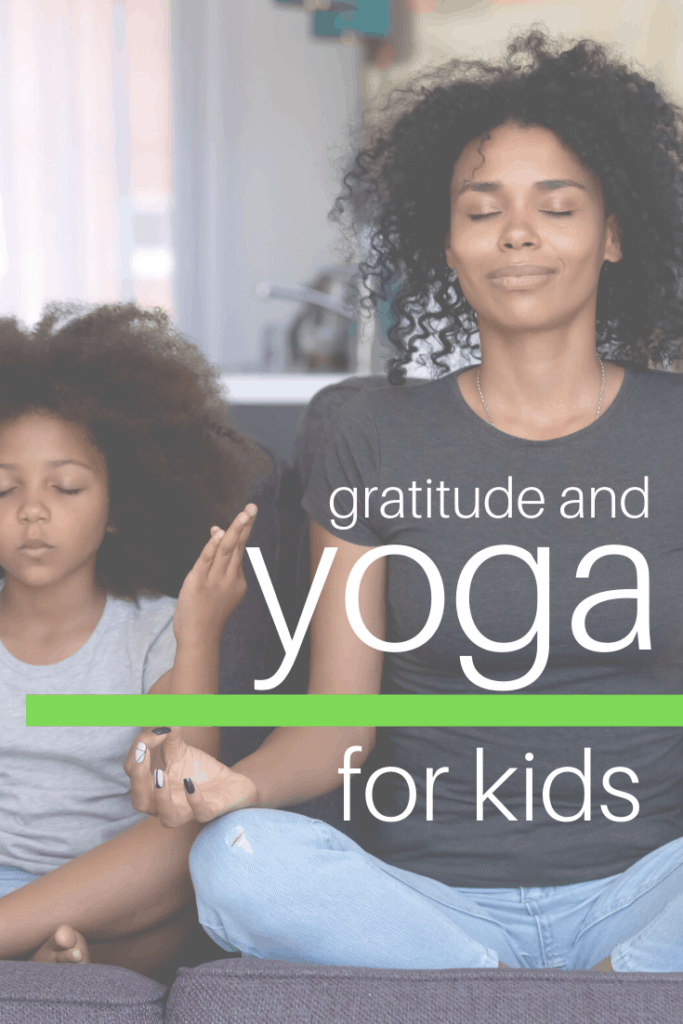
Why is gratitude important?
Well, there are a host of reasons why gratitude is important, and it has been studied much more in recent years. Some of the benefits that have been shown in these studies include :
- Improved relationships
- Becoming more generous, helpful, and compassionate
- Feeling less lonely or isolated
- Higher levels of positive emotions like joy, pleasure, and optimism
- Improved sleep
- Lower blood pressure
- Stronger immune systems
Read this article for more proof that gratitude can improve your quality of life.
What exactly is gratitude?
Gratitude is so much more than just saying please and thank you.
Those manners-based habits are important, of course, but a truly life-changing sense of gratitude is a culmination of these four things (as summarized in this article by Andrea Hussong, Greater Good Magazine, 2017):
- Notice: What are the things in our lives that we notice and can be grateful for?
- Think: What do we think are the reasons why we have been given these things?
- Feel: How do we feel about those things that we have been given in life?
- Do: What do we do to share that we are grateful for the things that we have been given?
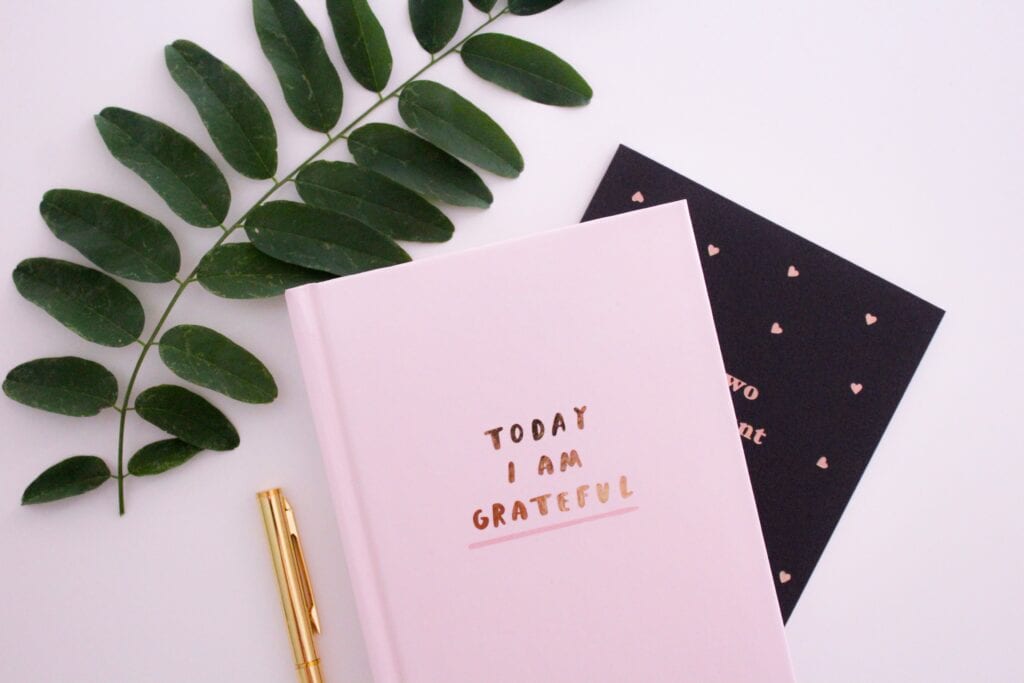
So what does this mean?
Gratitude is about paying attention to all that we benefit from in life, experiencing how it makes us feel, and then sharing that gratitude with others in order to give back and also to extend our appreciation for a longer time.
Using these senses to bring awareness to our gratitude is a great way to help kids actually learn how to feel grateful and recognize it more and more!
Incorporate gratitude activities for kids in a yoga and mindfulness lesson plan
How do you encourage kids to notice, think about, feel, and show gratitude on a more regular basis in yoga lessons?
Here are some ideas of how you can talk about gratitude in your yoga lessons with kids, some activities for practicing gratitude, and some yoga and mindfulness activities that go with the theme as well.
You can add in just a small activity or two in a class to get things started, then continue to reference these feelings and ideas over time. Gratitude should be a life long practice, not just something we learn about once and then walk away from.
Start to change your language and your own recognition of gratitude to TRULY make a difference in how you teach kids in your every day life.
Notice Gratitude
What are all the things/people/places/events that we are happy to have in our lives?
- Make a list as a class of things that you are grateful for
- Go on a nature- inspired gratitude scavenger hunt
- Create a gratitude collage
- Start a journal or draw some pictures of things you are thankful for, including people and places
- Thankful ABCs- go around in a circle or popcorn out ideas of something you are grateful for that start with each letter of the alphabet. Then make up a yoga pose to go with each item as well! It gets really creative and fun!
- Read a book about gratitude (see below)
- Use an adorable premade journal for kids to track moods and things you are grateful for
Think about Gratitude
Why have we been given these things?
(This can be easily incorporated into the “what portion”)
Think and talk about what you have, and where it comes from, or why you still have it in your life.
Sit in a circle and pass around a talking piece (a ball or stuffed animal). When you get the talking piece you can share one thing you are grateful for, and why you think you have been given it.
Make sure you give them “think time” first (or writing time) to generate their ideas before you start!
- Who gave it to you and why?
- Did you save money to buy it?
- Do your parents work hard so you can have food/a house/clothes/nice things?
- Have you taken good care of it?
- Do you have your friends because YOU are good friend?
- Are you in a great school because YOU work hard?
- Do you have great teachers because they care about kids?
Additionally, books about gratitude often talk about the “why” a lot, or help us generate ideas about why.
Here are some favorite books on gratitude and compassion for kids:
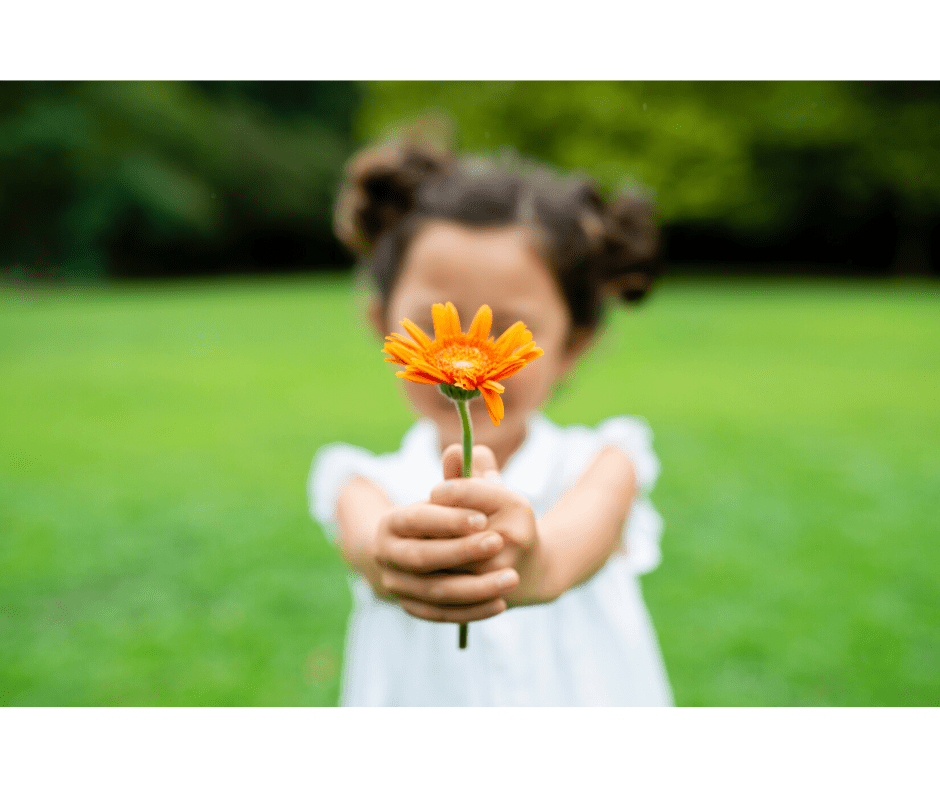
Feel Grateful
Feeling grateful for the things we have in our life and how they have affected us is where a lot of good yoga poses come in.
Most heart opener poses and backbends are excellent for opening up feelings, but don’t forget to counter them with some forward folds and poses that open up the upper back.
Yoga Flow for expressing gratitude and thankfulness
Here is how you can structure a Yoga Flow with extra backbends. Backbends are a great way to help open up your heart chakra and allow you to really notice those feelings of gratitude.
(To learn more about how to teach a basic Yoga Flow, click here!)
- Tadasana
- Crescent Moon (both sides)
- Waterfall (a few extra breaths)
- Forward fold
- Table top
- Cow pose–>Cat pose (go back and forth several times)
- Down dog
- Dragon (with extra back bend)–>Monkey (go back and forth several times)
- Table top
- Chaturanga
- Baby Cobra
- Crocodile
- Shark pose (reach your hands back behind your lower back and clasp them together like you have a shark fin)
- Up dog
- Child’s pose
- Table top
- Tiger (from table top, reach one hand forward and one leg straight back, do both sides for several breaths)
- Camel (hold for several breaths)
- Child’s pose
- Bridge pose
- Wheel pose
- Boat pose (to re-stabilize the core after so many back bends)
- Savasana
Take this Yoga Flow slowly, and make sure to pause to check in how kids are feeling. Lots of kids LOVE backbends and heart openers, but make sure they do the forward folds as well.
Ask how the poses feel. Ask what are they thinking? See if they share more or start to get more energy. Tell them what YOU are feeling and noticing as well!
Check out the Yoga Flow Pose Cards to get full-sized pose images of some of these Yoga Flow poses!
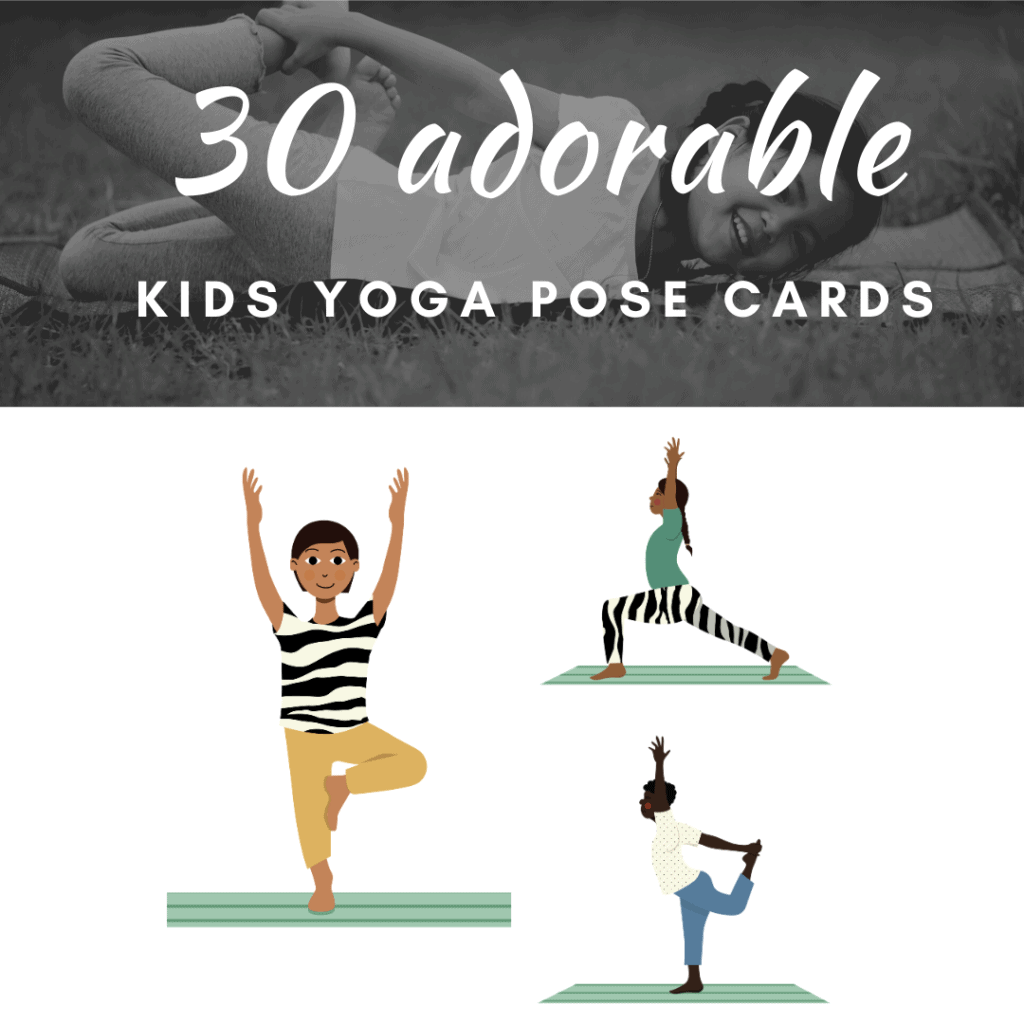
Another activity we have done is called “touch a person who…” I have done this gratitude activity with adults and kids, and it is always impactful.
- Split the group into two, with one group forming a small circle in the middle of the space. They can sit or stand. Instruct these kiddos to close their eyes and keep them closed, if possible, the whole time.
- The other kids are instructed to listen to a prompt, think, and then silently go around the circle and touch each person gently on the shoulder who fits that description for them.
- Model what the gentle tough on the shoulder should look like and feel like.
- Remind them they can (and should) go to several people for each prompt and that it should be silent so everyone can think and reflect.
- Talk first about how it might feel to not get touched after a prompt and how we might prevent anyone’s feelings getting hurt.
Prompt ideas for Gratitude Activity:
- Touch a person who…
- has smiled at you
- works hard
- has shown gratitude
- you are grateful for
- has made you laugh
- is doing their best
- has done something worthwhile
- is fun to be around
- you admire
Make sure to switch groups!
After the activity, leave time to talk about how it felt to be the giver of touches, and the receiver.
How did it feel to impact others so positively? How did it feel to receive such a physical representation of gratitude?
Give back! Share our gratitude with those who have helped us.
- Write a thank you note or draw a picture to someone you are grateful for. Use these printable thank you cards for kids to get them started.
- Make a whole bunch of paper or felt hearts and decorate them with kind and encouraging words. Pass them out to people you are grateful for as you see them throughout the day/week.
- Find a nonprofit in the community to collect pennies (or coins) to give back in donations.
- Go out and clean up your community! Bring trash bags and paper bags to pick up a park or along the sidewalks in your neighborhood.
- Have a food drive. Encourage kids to bring in canned goods to donate to a local food shelf.
- Visit a senior citizen center and spend time with the elderly. Talk, read books, and spend time with those who have helped build the community before us.

Yoga partner poses to share gratitude with physical support
The purpose of these poses is to support each other!
Give each other the support to balance longer, stretch a little more, or just feel supported with breath.
Back to Back Breathing:
Sit crisscross, back to back. Sit up tall with your hands on your knees. Close your eyes and breathe in and out deeply. Notice if you can feel your partner breathing. Don’t try to force your breath to match, but see if it starts to happen naturally.
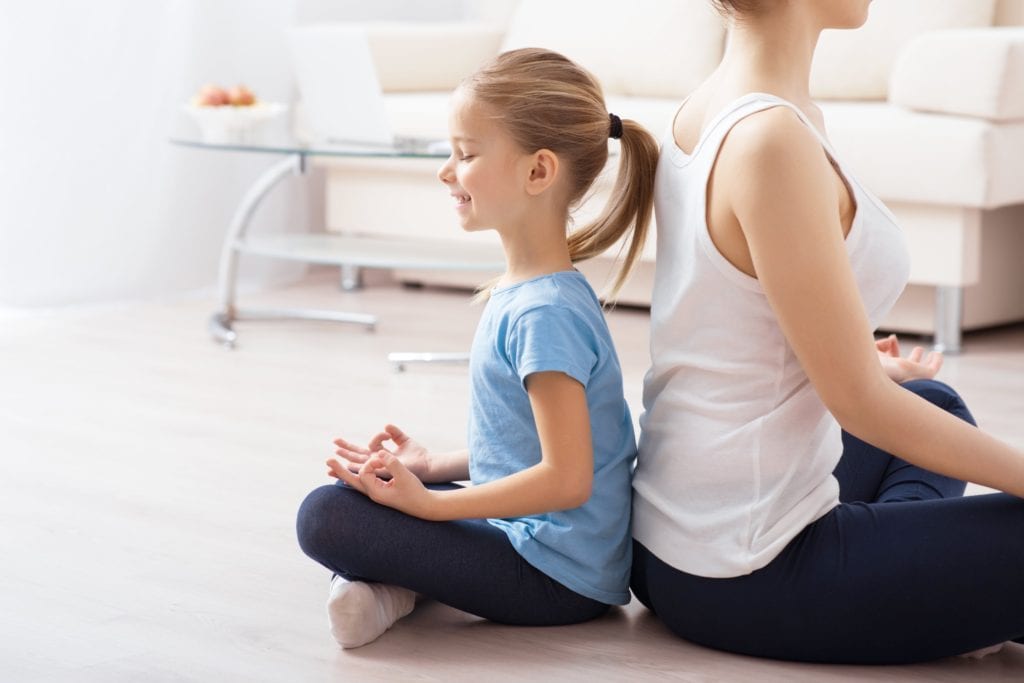
Back to Back Pretzel:
Still sitting back to back, take your right hand across your body to your left knee. Then bring your left hand out and behind you to your partner’s knee. They will be twisting towards you on the other side. Breathe in and sit up tall. Breathe out, and twist more towards your partner.
Lizard on a Rock:
Still sitting back to back, link elbows with your partner. One of you will lean forward over your legs as the other leans back. Keep your seat on the floor and relax backwards over your partner.
See-saw:
Sit facing your partner, with your legs straight out in front of you, feet touching. Reach for your partners hands. If you need to, separate your feet out wide and scoot closer together, but keep your legs straight. Gently pull your partner towards you until they say “stop” to help them stretch forward. Then let them pull you forward to stretch your legs and relax your back. Go slowly and take turns!
Double Boat:
Sit with your legs bent and feet touching your partner. Grab hold of each other’s hands and press your feet together, slowly lifting one at a time. Keep your knees bent, or try to straighten your legs all the way up!
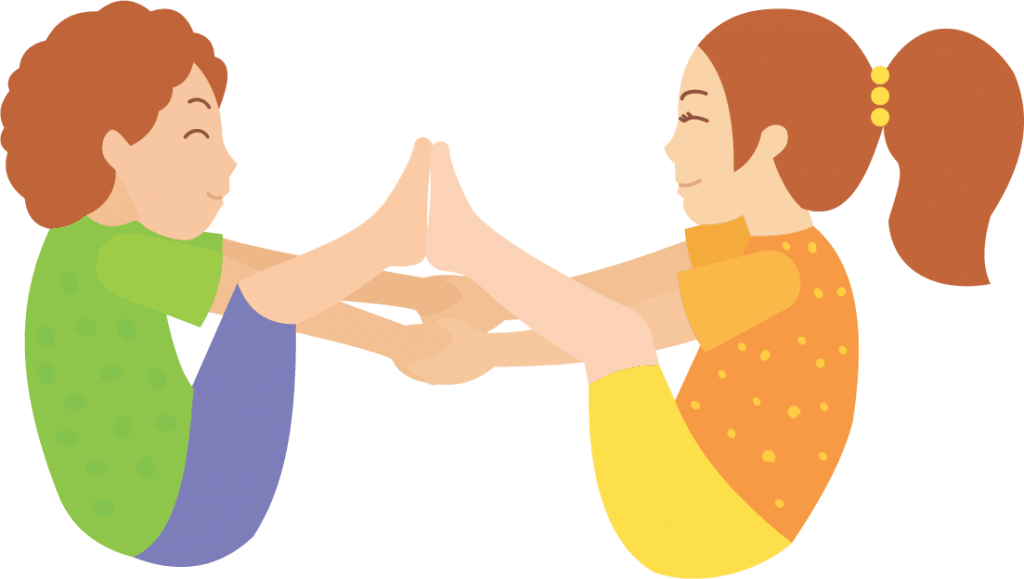
Standing Locust:
Stand back to back with your partner. Hold hands and take one step away from each other. Then, keeping your body straight, gently lean away from each other to stretch into a standing locust pose.
Partner Tree Pose:
Stand facing your partner with your hands gently touching in front of you. Lift your right foot up to rest on your leg. Press into each other’s hands gently to support each other in the balance. You can also do this side by side, with one arm around the other’s shoulder and the other hand across your body, palms touching your partner’s.
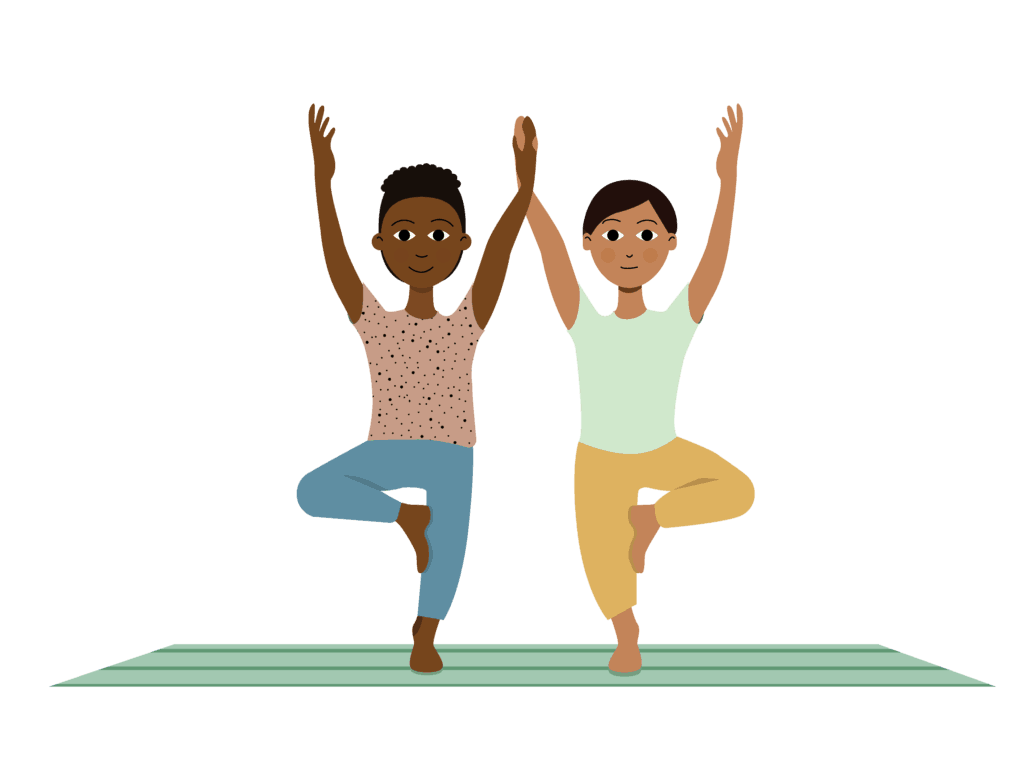
Partner Dancer:
Stand facing your partner with your right hand up, palms touching. Reach back with your left hand to your left ankle and press your leg away from you to come into dancer. Help each other balance! Alternatively, take turns doing the pose, while the other stands with both feet firmly planted on the ground, supporting the other with their hand up.
Partner Warrior 3:
Stand facing your partner with your hands on their shoulders. Take a few steps back, then lift your right leg straight behind you and lean forward into the support of your partner. Try to come parallel to the ground and balance!
I hope you enjoyed these teaching ideas for mindfulness and gratitude in a kids yoga class.
Don’t forget to check out these other lesson plan posts for kids yoga and mindfulness:
Teaching Kids Emotional Awareness with “My Many Colored Days” Yoga Lesson
Kid’s Yoga Story Lesson Plan based on the book Not a Box
Journey: An Active Kid’s Yoga Lesson Plan to Build a Love of Storytelling
Follow the Drinking Gourd: A kid’s yoga lesson plan with an equity mindset
Kids Yoga and Literacy Lesson Plan on Environmentalism

